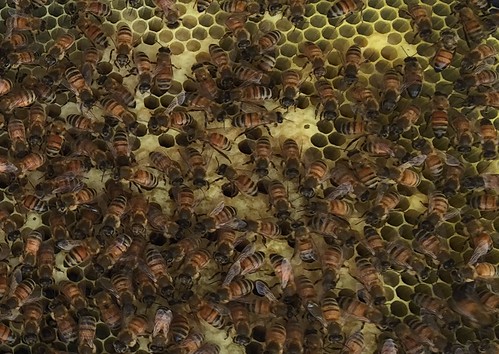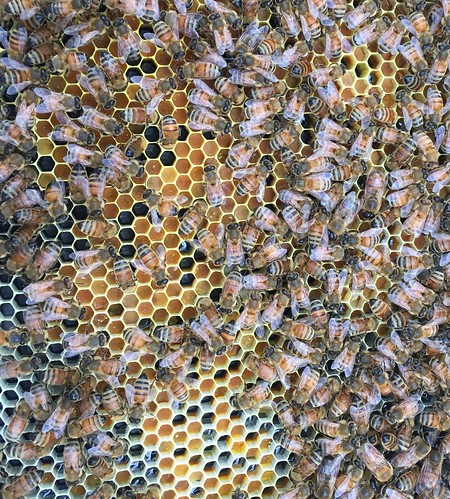Opened up the hive today to check on two key things:
#1 - Did the girls have enough sugar syrup in the feeder frame?
#2 - How much progress had they made on building out frames of honey comb?
Flowers are just starting to bloom in this area, and while I "think" there's enough natural nectar and pollen to be had, the feeder frame was just about dry. We refilled it just to be sure the bees had an ample supply of carbs. Pollen patty is getting worked through as well. My thinking is we can eliminate both in the next week to ten days.
Cool to see how much progress they're making on drawing out frames of comb. Of the 9 frames that are in the hive currently, it looks like they've made significant progress on filling the front & back of about 3.5 of them. The number would be higher if they had been working on frames instead of free-form building the comb in the space where the queen cage had previously been. But from what I can see, they are right on schedule.
I had posted pics of bee eggs previously. As the days have gone by, those eggs are now further developing in the larval stage. You can see bee larva in the comb in this photo. It's the curled up grub-like white mass at the bottom of the comb. The different size larva, I assume, indicates different ages with the larger larva having developed from eggs laid earlier in the process than the smaller ones. Educated guess on that.

Another interesting thing in the photo above is the relative size of a drone (male) bee to his chiquita worker bee counterparts. The drone is the big, burly fellow in the top quarter of the photo with the massive girth and huge eyes.
At some point in the larval stage -- around day 7 or 8 after being laid as an egg -- the bees will ensconce or "cap" the comb. It's kinda' like a caterpillar going into it's cocoon. The rest of the development process takes place over the next two weeks within the capped comb where the larva will pupate and metamorphosize into an adult bee.
You can see the capped comb in this photo.

The capping is made of the same bees wax as the comb itself, and while it appears very light & yellowish here, as the queen re-uses the comb for subsequent bees it will darken over time until it becomes almost black.
Super happy to see the bees are raising a lot of new siblings. The population of the hive has been slowly decreasing since the bees arrived. That's because it takes about three weeks for a new bee to form, but it looks like we're maybe 10-12 days from reversing that as new bees should start emerging around then. Really hoping I can grab some video of a bee eating it's way out of its cell.
And while this has been going on, the bees have also been making honey. They have to -- it's what they eat. The process is pretty complex and involves mixing nectar and pollen and water in the right amounts, then fanning it with their wings until it achieves a ratio of about 80% sugar and 18% water. Remaining 2% is made up of minerals, proteins, and some bee parts.


The honey is capped just like the brood is capped. Capping the honey allows the bees to safely store it until they need it for food down the line.